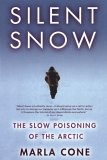Summary | Excerpt | Reviews | Beyond the Book | Readalikes | Genres & Themes | Author Bio

Critics' Opinion:
Readers' Opinion:
First Published:
Apr 2005, 256 pages
Paperback:
Apr 2006, 256 pages
 Book Reviewed by:
Book Reviewed by:
BookBrowse Review Team
Buy This Book
If scientists were to measure only physical, or abiotic, elements, the Arctic
environment would seem almost pristine, among the purest places on the planet.
The Great Lakes, the Baltic, and the North Sea, for example, hold ten to one
hundred times higher concentrations of PCBs than the Arctic Ocean. The air in
Chicago contains a lot more PCBs than the air in Svalbard, Norway. So if the air
they breathe and the water they drink and feed in are fairly clean, why do the
bodies of the Arctic's people and top predators carry so much toxic trash? How
contaminated an animal is depends not on where it lives but on what it eats—its
place in the hierarchy of life, the food chain, or more accurately the food web.
Capping a lush green and blue planet, the Earth's circumpolar north looks bleak
and uninhabitable but in reality its 13 million square miles—as vast as the
entire continents of North America and Europe combined—brim with an array of odd
and hardy creatures, from ice-clinging, single-celled algae to polar bears, that
can survive nowhere else on Earth. PCBs work their way through this ecosystem
from the bottom up. They are absorbed first by sediment on the ocean floor and
ice on the surface, and then they infiltrate single-celled plants that bloom
during the spring, when light becomes available for photosynthesis. Each
individual organism begins to build up the contaminants from its environment—a
process called bioaccumulation. These plants, sometimes stretching into
ten-foot-long filaments, are then grazed on by the ocean's zooplankton—tiny, shrimplike crustaceans such as copepods. From there, the Arctic's food chain
spreads into a vast, intricate web, reaching out in multiple directions. The
copepods are eaten by cod, the cod are eaten by toothed whales such as narwhals,
and the narwhals are eaten by Inuit hunters. Ringed seals eat the cod and then
polar bears and human hunters eat the seals. Walrus feast on the copepods,
people feast on the walrus. Seabirds eat cod, people eat the birds.
In the Arctic, you are what you eat. Because PCBs are not easily expelled from
an animal's body, they accumulate there—this means that animals at the top of
the food web have eaten all the contaminants consumed by their prey and their
prey's prey. Arctic food ladders have as many as five rungs, and at each step
up, the chemicals can magnify in concentration twentyfold or more in a
phenomenon called biomagnification. Occupying the top rung are people and
polar bears, which can carry millions, perhaps billions, of times more PCBs than
the waters where they harvest their foods.
This trip through the food web, in most cases, occurs via the fat of animals.
PCBs are not water-soluble, they are lipid-soluble, which means they are readily
absorbed by tissues with a high fat content, and they cling there, rather than
dissolving and flushing out of the body in liquids such as urine. "If you were
to ask a PCB molecule where do you like to be, it would say it likes to be in
the company of molecules similar to itself. As it looks around, the molecules
that are closest in chemical nature to PCBs are fats, or lipids. So PCBs tend to
accumulate in fat," says Donald Mackay of Trent University's Canadian
Environmental Modelling Centre. In cold climates like the Arctic, sea mammals
have an unusual propensity to produce fat. Their blubber is an insulating layer
several inches thick, and their milk is mostly fat. Fat stores energy, but it
also stores a variety of man-made chemicals, which makes Arctic mammals more
susceptible to the buildup of contaminants than leaner animals in temperate
zones. Making matters worse, many Arctic creatures experience seasonal cycles of
fattening and starvation, and when they use up their fat reserves in winter,
PCBs concentrate and migrate into their vital organs. Large Arctic predators
such as polar bears and whales also tend to live longer than land animals so
their bodies store many decades' worth of chemicals, increasing in concentration
with their age.
Copyright © 2005 by Marla Cone. Reprinted with permission from Grove Atlantic, Inc. All rights reserved.





The Funeral Cryer by Wenyan Lu
Debut novelist Wenyan Lu brings us this witty yet profound story about one woman's midlife reawakening in contemporary rural China.
Your guide toexceptional books
BookBrowse seeks out and recommends the best in contemporary fiction and nonfiction—books that not only engage and entertain but also deepen our understanding of ourselves and the world around us.